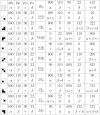Boolean analysis reveals systematic interactions among low-abundance species in the human gut microbiome
- PMID: 28640804
- PMCID: PMC5480827
- DOI: 10.1371/journal.pcbi.1005361
Boolean analysis reveals systematic interactions among low-abundance species in the human gut microbiome
Abstract
The analysis of microbiome compositions in the human gut has gained increasing interest due to the broader availability of data and functional databases and substantial progress in data analysis methods, but also due to the high relevance of the microbiome in human health and disease. While most analyses infer interactions among highly abundant species, the large number of low-abundance species has received less attention. Here we present a novel analysis method based on Boolean operations applied to microbial co-occurrence patterns. We calibrate our approach with simulated data based on a dynamical Boolean network model from which we interpret the statistics of attractor states as a theoretical proxy for microbiome composition. We show that for given fractions of synergistic and competitive interactions in the model our Boolean abundance analysis can reliably detect these interactions. Analyzing a novel data set of 822 microbiome compositions of the human gut, we find a large number of highly significant synergistic interactions among these low-abundance species, forming a connected network, and a few isolated competitive interactions.
Conflict of interest statement
The authors have declared that no competing interests exist.
Figures









Similar articles
-
Microbiome interactions shape host fitness.Proc Natl Acad Sci U S A. 2018 Dec 18;115(51):E11951-E11960. doi: 10.1073/pnas.1809349115. Epub 2018 Dec 3. Proc Natl Acad Sci U S A. 2018. PMID: 30510004 Free PMC article.
-
Metagenomic analysis of the human microbiome reveals the association between the abundance of gut bile salt hydrolases and host health.Gut Microbes. 2020 Sep 2;11(5):1300-1313. doi: 10.1080/19490976.2020.1748261. Epub 2020 Apr 24. Gut Microbes. 2020. PMID: 32329665 Free PMC article.
-
Two dynamic regimes in the human gut microbiome.PLoS Comput Biol. 2017 Feb 21;13(2):e1005364. doi: 10.1371/journal.pcbi.1005364. eCollection 2017 Feb. PLoS Comput Biol. 2017. PMID: 28222117 Free PMC article.
-
Human Gut Microbiome: Function Matters.Trends Microbiol. 2018 Jul;26(7):563-574. doi: 10.1016/j.tim.2017.11.002. Epub 2017 Nov 22. Trends Microbiol. 2018. PMID: 29173869 Review.
-
The gut mycobiota: insights into analysis, environmental interactions and role in gastrointestinal diseases.Nat Rev Gastroenterol Hepatol. 2019 Jun;16(6):331-345. doi: 10.1038/s41575-019-0121-2. Nat Rev Gastroenterol Hepatol. 2019. PMID: 30824884 Review.
Cited by
-
Identification of microbial interaction network: zero-inflated latent Ising model based approach.BioData Min. 2020 Oct 7;13:16. doi: 10.1186/s13040-020-00226-7. eCollection 2020. BioData Min. 2020. PMID: 33042226 Free PMC article.
-
From hairballs to hypotheses-biological insights from microbial networks.FEMS Microbiol Rev. 2018 Nov 1;42(6):761-780. doi: 10.1093/femsre/fuy030. FEMS Microbiol Rev. 2018. PMID: 30085090 Free PMC article. Review.
-
Evaluating changes in attractor sets under small network perturbations to infer reliable microbial interaction networks from abundance patterns.Bioinformatics. 2025 Mar 29;41(4):btaf095. doi: 10.1093/bioinformatics/btaf095. Bioinformatics. 2025. PMID: 40036964 Free PMC article.
-
Connectivity and complex systems: learning from a multi-disciplinary perspective.Appl Netw Sci. 2018;3(1):11. doi: 10.1007/s41109-018-0067-2. Epub 2018 Jun 18. Appl Netw Sci. 2018. PMID: 30839779 Free PMC article. Review.
-
Shrinkage improves estimation of microbial associations under different normalization methods.NAR Genom Bioinform. 2020 Dec 17;2(4):lqaa100. doi: 10.1093/nargab/lqaa100. eCollection 2020 Dec. NAR Genom Bioinform. 2020. PMID: 33575644 Free PMC article.
References
-
- Langille MG, Zaneveld J, Caporaso JG, McDonald D, Knights D, Reyes JA, Clemente JC, Burkepile DE, Thurber RLV, Knight R, et al. Predictive functional profiling of microbial communities using 16s rrna marker gene sequences. Nature Biotechnology. 2013;31(9):814–821. 10.1038/nbt.2676 - DOI - PMC - PubMed
MeSH terms
LinkOut - more resources
Full Text Sources
Other Literature Sources

